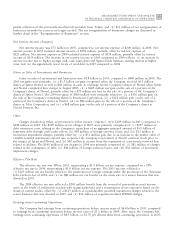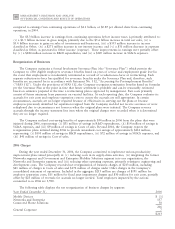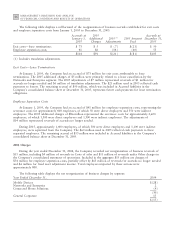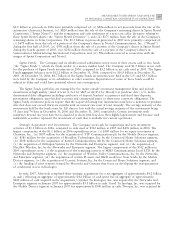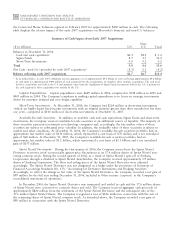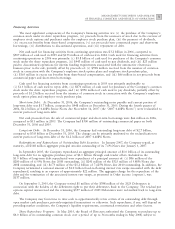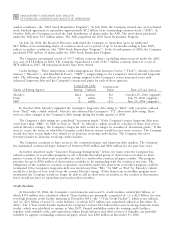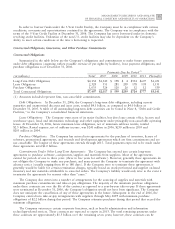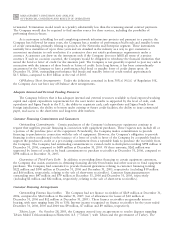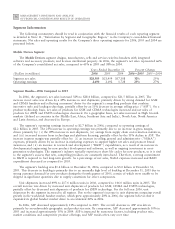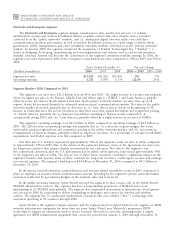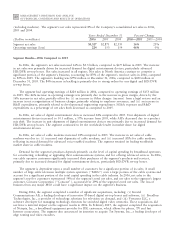Motorola 2006 Annual Report Download - page 61
Download and view the complete annual report
Please find page 61 of the 2006 Motorola annual report below. You can navigate through the pages in the report by either clicking on the pages listed below, or by using the keyword search tool below to find specific information within the annual report.
53
MANAGEMENT'S DISCUSSION AND ANALYSIS
OF FINANCIAL CONDITION AND RESULTS OF OPERATIONS
In order to borrow funds under the 5-Year Credit Facility, the Company must be in compliance with various
conditions, covenants and representations contained in the agreements. The Company was in compliance with the
terms of the 5-Year Credit Facility at December 31, 2006. The Company has never borrowed under its domestic
revolving credit facilities. Utilization of the non-U.S. credit facilities may also be dependent on the Company's
ability to meet certain conditions at the time a borrowing is requested.
Contractual Obligations, Guarantees, and Other Purchase Commitments
Contractual Obligations
Summarized in the table below are the Company's obligations and commitments to make future payments
under debt obligations (assuming earliest possible exercise of put rights by holders), lease payment obligations, and
purchase obligations as of December 31, 2006.
Payments Due by Period(1)
(in millions) Total 2007 2008 2009 2010 2011 Thereafter
Long-Term Debt Obligations $4,134 $1,340 $ 198 $ 4 $534 $607 $1,451
Lease Obligations 2,328 351 281 209 178 158 1,151
Purchase Obligations 1,035 326 120 26 12 12 539
Total Contractual Obligations $7,497 $2,017 $ 599 $239 $724 $777 $3,141
(1) Amounts included represent firm, non-cancelable commitments.
Debt Obligations: At December 31, 2006, the Company's long-term debt obligations, including current
maturities and unamortized discount and issue costs, totaled $4.1 billion, as compared to $4.0 billion at
December 31, 2005. A table of all outstanding long-term debt securities can be found in Note 4, ""Debt and Credit
Facilities,'' to the Company's consolidated financial statements.
Lease Obligations: The Company owns most of its major facilities, but does lease certain office, factory and
warehouse space, land, and information technology and other equipment under principally non-cancelable operating
leases. At December 31, 2006, future minimum lease obligations, net of minimum sublease rentals, totaled
$2.3 billion. Rental expense, net of sublease income, was $241 million in 2006, $250 million in 2005 and
$205 million in 2004.
Purchase Obligations: The Company has entered into agreements for the purchase of inventory, license of
software, promotional agreements, and research and development agreements which are firm commitments and are
not cancelable. The longest of these agreements extends through 2015. Total payments expected to be made under
these agreements total $1.0 billion.
Commitments Under Other Long-Term Agreements: The Company has entered into certain long-term
agreements to purchase software, components, supplies and materials from suppliers. Most of the agreements
extend for periods of one to three years (three to five years for software). However, generally these agreements do
not obligate the Company to make any purchases, and many permit the Company to terminate the agreement with
advance notice (usually ranging from 60 to 180 days). If the Company were to terminate these agreements, it
generally would be liable for certain termination charges, typically based on work performed and supplier on-hand
inventory and raw materials attributable to canceled orders. The Company's liability would only arise in the event it
terminates the agreements for reasons other than ""cause.''
The Company also enters into a number of arrangements for the sourcing of supplies and materials with
minimum purchase commitments and take-or-pay obligations. The majority of the minimum purchase obligations
under these contracts are over the life of the contract as opposed to a year-by-year take-or-pay. If these agreements
were terminated at December 31, 2006, the Company's obligation would not have been significant. The Company
does not anticipate the cancellation of any of these agreements in the future. Subsequent to the end of 2006, the
Company entered into take-or-pay arrangements with suppliers through May 2009 with minimum purchase
obligations of $2.2 billion during that period. The Company estimates purchases during that period that exceed the
minimum obligations.
The Company outsources certain corporate functions, such as benefit administration and information
technology-related services. These contracts are expected to expire in 2013. The total remaining payments under
these contracts are approximately $1.3 billion over the remaining seven years; however, these contracts can be


